2009 PONTIAC G8 belt
[x] Cancel search: beltPage 1 of 356

Seats and Restraints......... 1-1
Front Seats
.................... 1-2
Rear Seats
.................... 1-5
Safety Belts
................... 1-5
Airbag System
..............1-20
Child Restraints
.............1-34
Keys, Doors and
Windows............................ 2-1
Keys
............................. 2-2
Doors and Locks
............ 2-8
Theft-Deterrent
Systems
...................2-11
Windows
......................2-14
Mirrors
.........................2-16
Sunroof
........................2-18
Storage.............................. 3-1
Storage
......................... 3-1
Instruments and
Controls............................. 4-1
Instrument Panel
Overview
.................... 4-2
Warning Lights, Gages, and
Indicators
..................4-10Driver Information
Center (DIC)
.............4-22
OnStar
®System
............4-35
Lighting............................. 5-1
Lighting
......................... 5-1
Infotainment...................... 6-1
Audio System(s)
............. 6-1
Climate Controls............... 7-1
Climate Controls
............. 7-1
Driving and Operating....... 8-1
Starting and Operating
Your Vehicle
............... 8-2
Driving Your Vehicle
......8-16
Fuel
............................8-34
Vehicle Service
and Care............................ 9-1
Service
.......................... 9-2
Owner Checks
................ 9-5
Headlamp Aiming
..........9-28
Bulb Replacement
.........9-31
Electrical System
...........9-36
Tires
...........................9-42Tire Changing
...............9-66
Jump Starting
...............9-84
Towing
........................9-88
Appearance Care
..........9-95
Technical Data.................10-1
Vehicle Identi�cation
......10-1
Capacities and
Speci�cations
............10-2
Service and
Maintenance.....................11-1
Service and
Maintenance
..............11-1
Customer Information......12-1
Customer Information
.....12-1
Reporting Safety
Defects
...................12-14
Vehicle Data Recording
and Privacy
.............12-16
Index....................................i-1
2009 Pontiac G8 Owner ManualM
Page 5 of 356
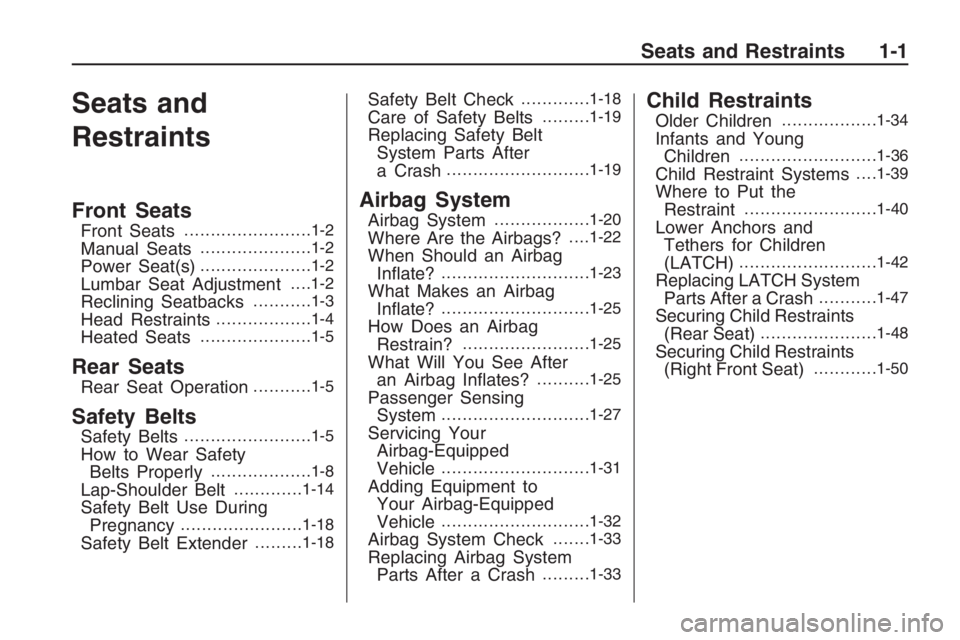
Seats and
Restraints
Front Seats
Front Seats........................1-2
Manual Seats.....................1-2
Power Seat(s).....................1-2
Lumbar Seat Adjustment. . . .1-2
Reclining Seatbacks...........1-3
Head Restraints..................1-4
Heated Seats.....................1-5
Rear Seats
Rear Seat Operation...........1-5
Safety Belts
Safety Belts........................1-5
How to Wear Safety
Belts Properly...................1-8
Lap-Shoulder Belt.............1-14
Safety Belt Use During
Pregnancy.......................1-18
Safety Belt Extender.........1-18
Safety Belt Check.............1-18
Care of Safety Belts.........1-19
Replacing Safety Belt
System Parts After
a Crash
...........................1-19
Airbag System
Airbag System..................1-20
Where Are the Airbags?. . . .1-22
When Should an Airbag
In�ate?............................1-23
What Makes an Airbag
In�ate?............................1-25
How Does an Airbag
Restrain?........................1-25
What Will You See After
an Airbag In�ates?..........1-25
Passenger Sensing
System............................1-27
Servicing Your
Airbag-Equipped
Vehicle
............................1-31
Adding Equipment to
Your Airbag-Equipped
Vehicle
............................1-32
Airbag System Check.......1-33
Replacing Airbag System
Parts After a Crash.........1-33
Child Restraints
Older Children..................1-34
Infants and Young
Children..........................1-36
Child Restraint Systems. . . .1-39
Where to Put the
Restraint.........................1-40
Lower Anchors and
Tethers for Children
(LATCH)
..........................1-42
Replacing LATCH System
Parts After a Crash...........1-47
Securing Child Restraints
(Rear Seat)......................1-48
Securing Child Restraints
(Right Front Seat)............1-50
Seats and Restraints 1-1
Page 7 of 356
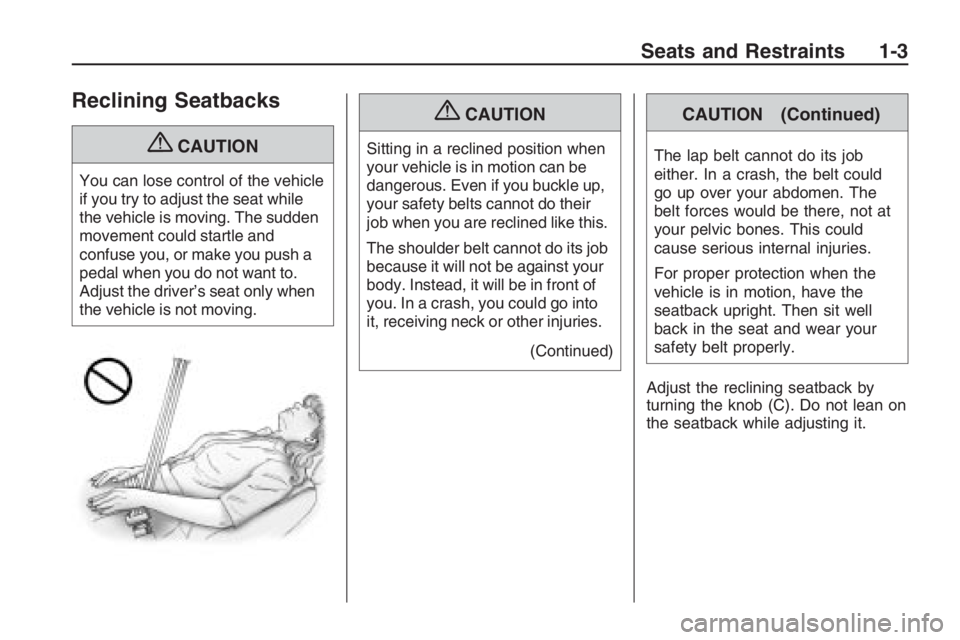
Reclining Seatbacks
{CAUTION
You can lose control of the vehicle
if you try to adjust the seat while
the vehicle is moving. The sudden
movement could startle and
confuse you, or make you push a
pedal when you do not want to.
Adjust the driver’s seat only when
the vehicle is not moving.
{CAUTION
Sitting in a reclined position when
your vehicle is in motion can be
dangerous. Even if you buckle up,
your safety belts cannot do their
job when you are reclined like this.
The shoulder belt cannot do its job
because it will not be against your
body. Instead, it will be in front of
you. In a crash, you could go into
it, receiving neck or other injuries.
(Continued)
CAUTION (Continued)
The lap belt cannot do its job
either. In a crash, the belt could
go up over your abdomen. The
belt forces would be there, not at
your pelvic bones. This could
cause serious internal injuries.
For proper protection when the
vehicle is in motion, have the
seatback upright. Then sit well
back in the seat and wear your
safety belt properly.
Adjust the reclining seatback by
turning the knob (C). Do not lean on
the seatback while adjusting it.
Seats and Restraints 1-3
Page 9 of 356
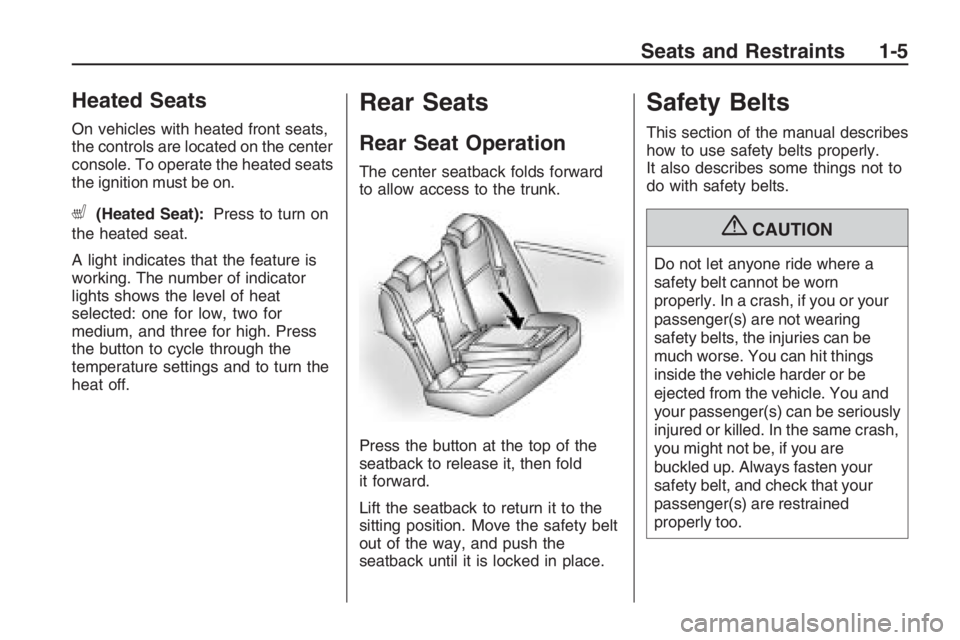
Heated Seats
On vehicles with heated front seats,
the controls are located on the center
console. To operate the heated seats
the ignition must be on.
L(Heated Seat):Press to turn on
the heated seat.
A light indicates that the feature is
working. The number of indicator
lights shows the level of heat
selected: one for low, two for
medium, and three for high. Press
the button to cycle through the
temperature settings and to turn the
heat off.
Rear Seats
Rear Seat Operation
The center seatback folds forward
to allow access to the trunk.
Press the button at the top of the
seatback to release it, then fold
it forward.
Lift the seatback to return it to the
sitting position. Move the safety belt
out of the way, and push the
seatback until it is locked in place.
Safety Belts
This section of the manual describes
how to use safety belts properly.
It also describes some things not to
do with safety belts.
{CAUTION
Do not let anyone ride where a
safety belt cannot be worn
properly. In a crash, if you or your
passenger(s) are not wearing
safety belts, the injuries can be
much worse. You can hit things
inside the vehicle harder or be
ejected from the vehicle. You and
your passenger(s) can be seriously
injured or killed. In the same crash,
you might not be, if you are
buckled up. Always fasten your
safety belt, and check that your
passenger(s) are restrained
properly too.
Seats and Restraints 1-5
Page 10 of 356
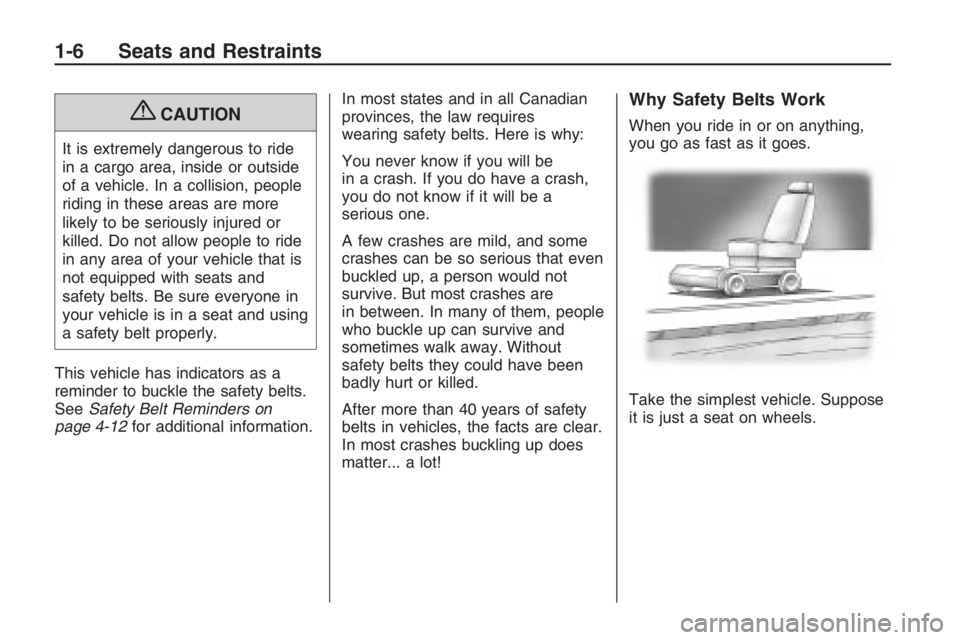
{CAUTION
It is extremely dangerous to ride
in a cargo area, inside or outside
of a vehicle. In a collision, people
riding in these areas are more
likely to be seriously injured or
killed. Do not allow people to ride
in any area of your vehicle that is
not equipped with seats and
safety belts. Be sure everyone in
your vehicle is in a seat and using
a safety belt properly.
This vehicle has indicators as a
reminder to buckle the safety belts.
SeeSafety Belt Reminders on
page 4-12for additional information.In most states and in all Canadian
provinces, the law requires
wearing safety belts. Here is why:
You never know if you will be
in a crash. If you do have a crash,
you do not know if it will be a
serious one.
A few crashes are mild, and some
crashes can be so serious that even
buckled up, a person would not
survive. But most crashes are
in between. In many of them, people
who buckle up can survive and
sometimes walk away. Without
safety belts they could have been
badly hurt or killed.
After more than 40 years of safety
belts in vehicles, the facts are clear.
In most crashes buckling up does
matter... a lot!
Why Safety Belts Work
When you ride in or on anything,
you go as fast as it goes.
Take the simplest vehicle. Suppose
it is just a seat on wheels.
1-6 Seats and Restraints
Page 11 of 356
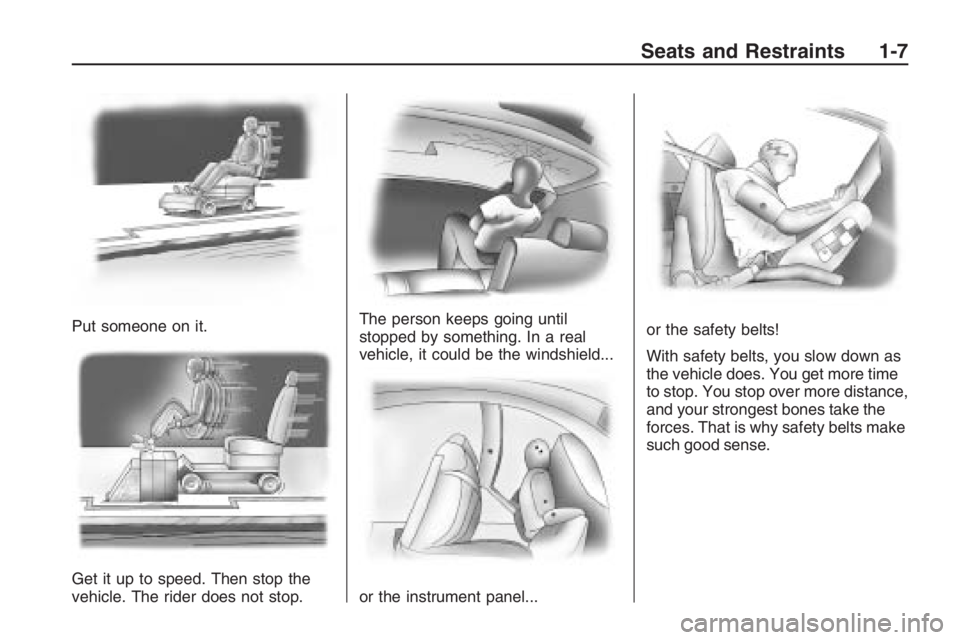
Put someone on it.
Get it up to speed. Then stop the
vehicle. The rider does not stop.The person keeps going until
stopped by something. In a real
vehicle, it could be the windshield...
or the instrument panel...or the safety belts!
With safety belts, you slow down as
the vehicle does. You get more time
to stop. You stop over more distance,
and your strongest bones take the
forces. That is why safety belts make
such good sense.
Seats and Restraints 1-7
Page 12 of 356

Questions and Answers About
Safety Belts
Q:
Will I be trapped in the vehicle
after a crash if I am wearing a
safety belt?
A:Youcouldbe — whether you are
wearing a safety belt or not. But
your chance of being conscious
during and after an accident, so
youcanunbuckle and get out, is
muchgreater if you are belted.
And you can unbuckle a safety
belt, even if you are upside down.
Q:If my vehicle has airbags,
why should I have to wear
safety belts?
A:Airbags are supplemental
systems only; so they workwith
safety belts — not instead of
them. Whether or not an airbag is
provided, all occupants still have
to buckle up to get the most
protection. That is true not only in
frontal collisions, but especially in
side and other collisions.
Q:If I am a good driver, and I
never drive far from home,
why should I wear safety
belts?
A:You may be an excellent driver,
but if you are in a crash — even
one that is not your fault — you
and your passenger(s) can be
hurt. Being a good driver does not
protect you from things beyond
your control, such as bad drivers.
Most accidents occur within
25 miles (40 km) of home. And
the greatest number of serious
injuries and deaths occur at
speeds of less than 40 mph
(65 km/h).
Safety belts are for everyone.
How to Wear Safety Belts
Properly
This section is only for people of
adult size.
Be aware that there are special
things to know about safety
belts and children. And there are
different rules for smaller children
and infants. If a child will be riding in
the vehicle, seeOlder Children on
page 1-34orInfants and Young
Children on page 1-36. Follow those
rules for everyone’s protection.
It is very important for all occupants
to buckle up. Statistics show that
unbelted people are hurt more often
in crashes than those who are
wearing safety belts.
Occupants who are not buckled up
can be thrown out of the vehicle
in a crash. And they can strike
others in the vehicle who are
wearing safety belts.
1-8 Seats and Restraints
Page 13 of 356
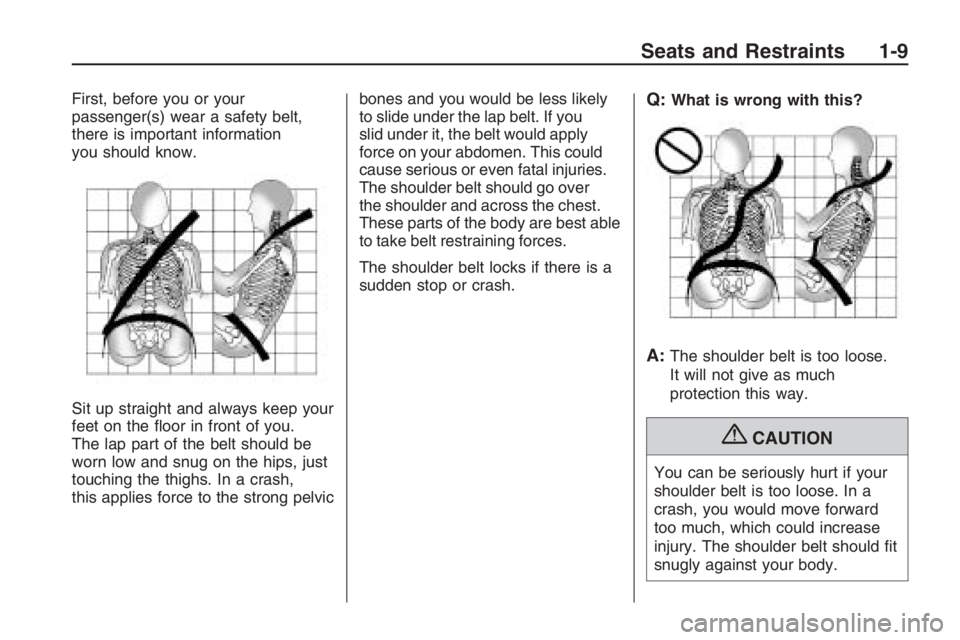
First, before you or your
passenger(s) wear a safety belt,
there is important information
you should know.
Sit up straight and always keep your
feet on the �oor in front of you.
The lap part of the belt should be
worn low and snug on the hips, just
touching the thighs. In a crash,
this applies force to the strong pelvicbones and you would be less likely
to slide under the lap belt. If you
slid under it, the belt would apply
force on your abdomen. This could
cause serious or even fatal injuries.
The shoulder belt should go over
the shoulder and across the chest.
These parts of the body are best able
to take belt restraining forces.
The shoulder belt locks if there is a
sudden stop or crash.Q:What is wrong with this?
A:The shoulder belt is too loose.
It will not give as much
protection this way.
{CAUTION
You can be seriously hurt if your
shoulder belt is too loose. In a
crash, you would move forward
too much, which could increase
injury. The shoulder belt should �t
snugly against your body.
Seats and Restraints 1-9